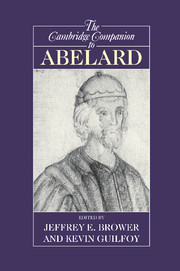2 - Literary works
Published online by Cambridge University Press: 28 May 2006
Summary
Though the main concern of this volume is Abelard's work in philosophy and theology, he made important and original contributions in a number of fields. His substantial essays in apologetic and biblical exegesis are discussed in other chapters. Studies still in progress are revealing his extensive and wide-ranging activity as a liturgist, and seeking to recover concrete evidence of his work as a composer of music. But his most remarkable non-philosophical role is as a literary artist, a master of narrative and lyric form who produced art of a high order out of his own complex and tormented life.
Any account of Abelard the artist must begin with the Historia calamitatum, the narrative of his struggles as man, philosopher, and monk over thirty years. Ostensibly written to console an unnamed friend by inviting him to contrast his own misfortunes with the far greater sufferings of Abelard, the Historia seems clearly to have been designed to engage a wider audience. Whether viewed as an authentic apologia pro vita sua or as an astute exercise in historical romance, this unique document and the story it tells have inevitably defined our sense of the character and personality of Abelard. So compelling is the Historia indeed, so evocative of romance and hagiography in its framing of the crucial events of Abelard’s life, and so eloquent in the lessons it draws from these events, that it is hard to resist the suspicion that it is essentially a work of imaginative fiction. But it is unique too in that its historicity has been tested perhaps as rigorously as that of any comparable work. Its status as a work of Abelard, and as initiating the series of “personal” letters by Abelard and Heloise that accompany it in virtually all manuscripts, now seems to have been decisively established, while the exhaustive readings to which it has been subjected have greatly enhanced our ability to appreciate it as a literary text.
- Type
- Chapter
- Information
- The Cambridge Companion to Abelard , pp. 45 - 64Publisher: Cambridge University PressPrint publication year: 2004
- 2
- Cited by

